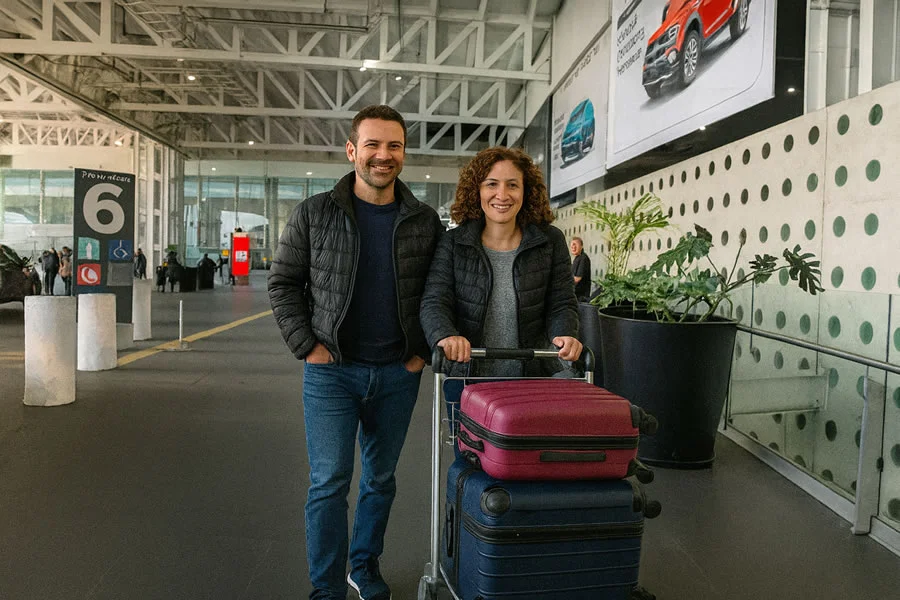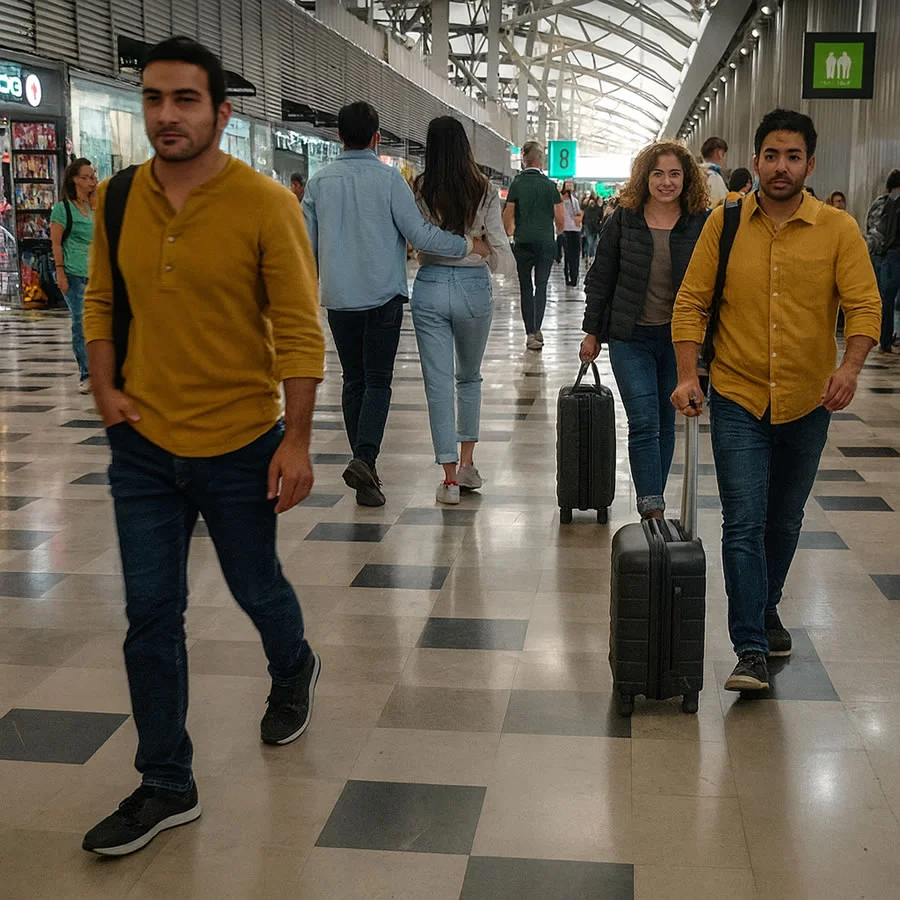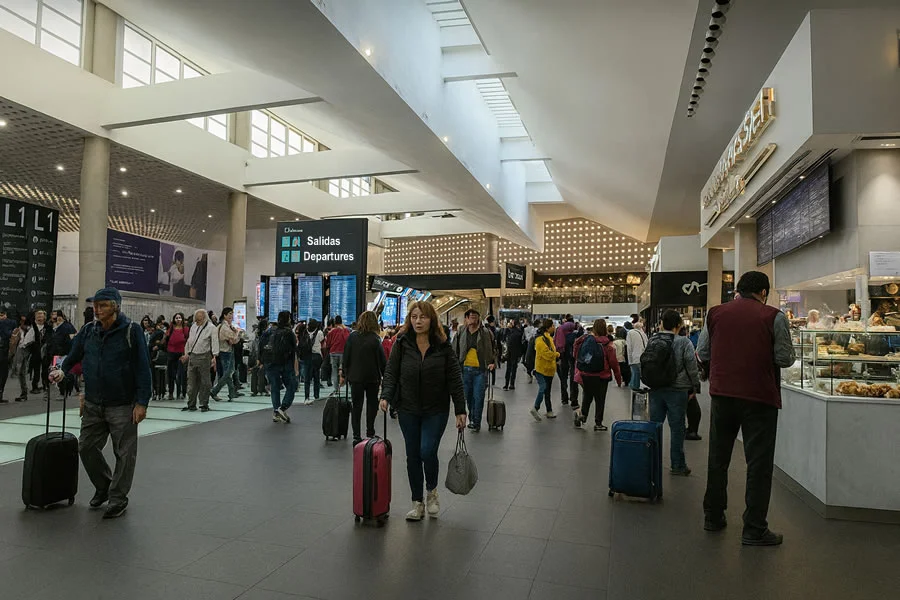NON OFFICIAL - To reach the official website visit aicm.com.mx
AICM Terminals Guide: Navigating Between T1 and T2
Mexico City International Airport (AICM) is divided into two large buildings: Terminal 1, a giant full of history and activity, and Terminal 2, more modern and compact. Although both share the same airspace, their characteristics, airlines, and the experience they offer are very different. Here we present a detailed manual, enriched with the experience of thousands of travelers, so you know what to expect in each and how to move between them without setbacks.
Frequently Asked Questions about the Terminals
Which terminal is better, T1 or T2?
There is no "better" terminal; it depends on your airline and priorities. T1 is larger and houses most of the airlines, offering a vast range of shops and restaurants. However, its size and age make it more prone to chaos and confusion. T2 is more modern, compact, and easy to navigate, but mainly concentrates Aeroméxico and its partners, and can feel just as saturated during peak hours.
Is it easy to change terminals?
The transfer is relatively simple using the Aerotrén (if you have a boarding pass) or the connection bus. The main challenge, according to users, is the signage to find the access points, especially for the Aerotrén in T1. In addition, the train may suspend its service, forcing the use of the bus, which is subject to traffic.
How far in advance should I arrive at AICM?
The general recommendation is to arrive 3 hours early for international flights and 2 for domestic. However, given the airport's saturation, ongoing renovations, and possible delays in security and immigration, many travelers suggest adding an extra margin of 30 to 60 minutes to avoid stress.
Is it hot in the airport? Is there air conditioning?
It is a recurring complaint, especially in Terminal 1. Many users report that the air conditioning system is insufficient, creating a feeling of heat and stuffiness, especially in crowded areas. It is recommended to wear light or layered clothing for greater comfort.

AI-generated image
Traveler's Handbook: Critical Points of the Terminals
The Challenge of Orientation and Signage
The size of T1 and signage that many consider confusing or insufficient are a constant point of friction. Gates can be announced or changed at the last minute. Your strategy: arrive with plenty of time, constantly check the flight information screens, and do not hesitate to ask airport staff to confirm your route.
An Airport in Constant Renovation
Both terminals, especially during 2025, are undergoing major renovation works. This translates into noise, dust, blocked corridors, and a general feeling of chaos. Your strategy: be patient, follow the marked alternative routes, and consider that walking times within the terminal may be longer than usual.
The Wait for Luggage and Security
Delays in baggage delivery are one of the most frequent complaints, with waits that can exceed an hour. In addition, there are recurring reports of theft of belongings from checked luggage. Your strategy: pack valuables in your carry-on luggage and consider using locks or plastic wrapping for your suitcases. Be patient at the baggage carousels.
Saturation and Lack of Space
AICM operates above its capacity, resulting in crowded waiting rooms, few available chairs, and long lines for almost everything. Your strategy: if you are traveling in a group, find a meeting point. If you have access to VIP lounges, use them to escape the hustle and bustle. Otherwise, be prepared to wait standing during peak hours.
Terminal 1: The largest and busiest
Terminal 1 (T1) is the largest at the airport and one of the largest in Latin America. It operates domestic and international flights and houses most of the airlines, including American Airlines, Air Canada, United, Iberia, Volaris, and VivaAerobus, among others.

AI-generated image
User Experience:
Travelers describe T1 as a functional but chaotic giant. Its main advantage is the huge variety of services, shops, and restaurants. However, its disadvantages are equally notable: its age is evident in the wear and tear of the facilities, the lack of efficient air conditioning is a constant complaint, and its complex layout, combined with poor signage, makes finding your way a real challenge. It is common to feel lost or to walk long distances to get to the gates.
Distribution by levels
- Ground Floor (Level 1)
- Domestic and international arrivals
- Customs and immigration area
- Baggage claim
- Access to ground transportation (taxis, car rentals, and buses)
- Connection to the Aerotrén to Terminal 2
- Transit and capsule hotels (Izzzleep)
- Some shops, restaurants, and currency exchange offices
- First Level (Level 2)
- Domestic and international departures
- Check-in counters
- Security checkpoints
- Waiting rooms
- Most dining and shopping options
- Access to VIP Lounges
Concourses and Gates
Terminal 1 has a gate and concourse distribution divided into several sections, which can add to the confusion:
- Concourse A: Gates 1-6 (mainly domestic flights)
- Concourse B: Gates 7-11 (domestic and international flights)
- Concourse C: Gates 20-29 (international and connections)
- Concourse D: Gates 30-36 (international and flights of airlines like United, Lufthansa, Air France, etc.)
- Concourses E and F: Intended for international flights of specific airlines
Terminal 2: The most modern and compact
Terminal 2 (T2) is newer and has a contemporary design, built to improve efficiency. It is the main hub for Aeroméxico and its partner airlines of the SkyTeam alliance, such as Delta, Air France, and Copa Airlines.

AI-generated image
User Experience:
Generally, travelers find T2 easier to navigate due to its more logical and compact design. The facilities are perceived as cleaner and more modern. However, it is not without problems: saturation during peak hours is the same or worse than in T1, with insufficient waiting areas and long lines at security and immigration. In addition, the current renovations also generate noise and inconvenience, and some users point out that despite being newer, it already shows signs of lack of maintenance.
Distribution by levels
- Ground Floor (Level 1)
- Domestic and international arrivals
- Baggage claim and customs
- Connection to ground transportation
- Taxi and car rental area
- First Level (Level 2)
- Domestic and international departures
- Check-in counters
- Security checkpoints
- Waiting rooms and access to boarding gates
- Commercial and dining areas
- Access to VIP Lounges (Salón Premier, American Express Centurion, among others)
Concourses and Gates
Compared to T1, Terminal 2 has a simpler and more linear layout:
- Concourse K: Gates 52-62 (mostly domestic flights)
- Concourse L: Gates 63-75 (international and Aeroméxico and SkyTeam flights)
- Concourse M: Gates 76-89 (international airline flights and some domestic connections)
Connection between terminals: Aerotrén and Buses
The terminals are separated by more than 3 km, so it is not possible to walk between them. You will need to use one of the airport's transportation systems.
User Experience:
The connection system generates divided opinions. The Aerotrén is praised for its speed, but criticized for the poor signage to find it, especially in T1. In addition, interruptions in its service have been reported, forcing passengers to use the buses. The latter are a functional alternative, but their frequency can be irregular and the journey is slower, as it is subject to the dense airport traffic.
Aerotrén
- Cost: Free.
- Access requirement: Only for passengers with a valid boarding pass for the same day (printed or digital).
- Travel time: Approximately 5 to 7 minutes.
- Capacity: 100 people with carry-on luggage.
- Access location:
- Terminal 1: Halfway through the "Puente de Pilotos", going up the escalators in Concourse D.
- Terminal 2: Next to the domestic departures hall, in Concourse M.
Connection Buses
- Cost: Free for connecting passengers. It also serves as an alternative when the Aerotrén is not operational.
- Transfer time: Approximately 10-15 minutes, although it can vary significantly depending on traffic.
- Location:
- Terminal 1: Gate 6 (formerly Gate 7).
- Terminal 2: Gate 4.
